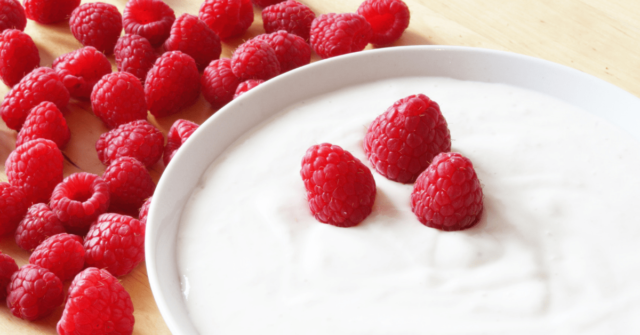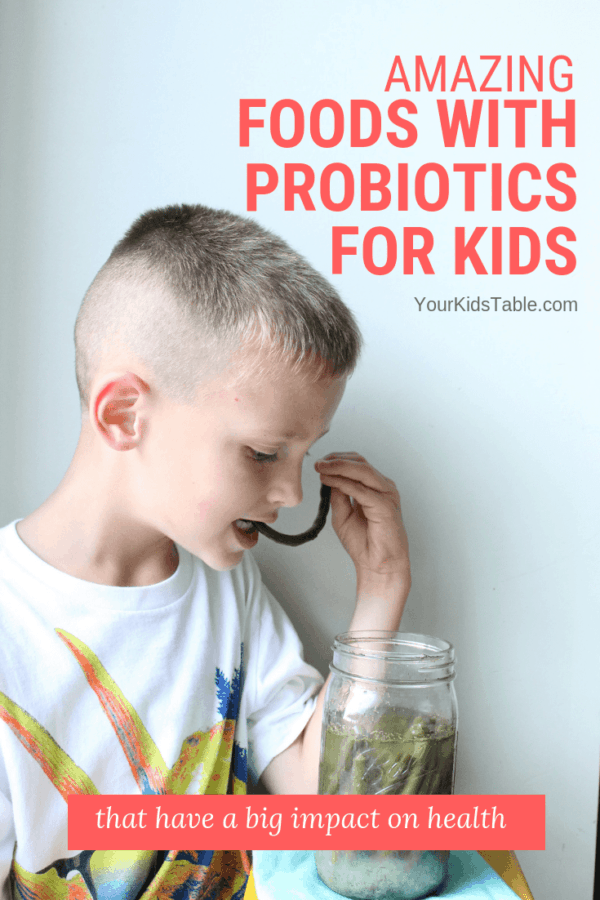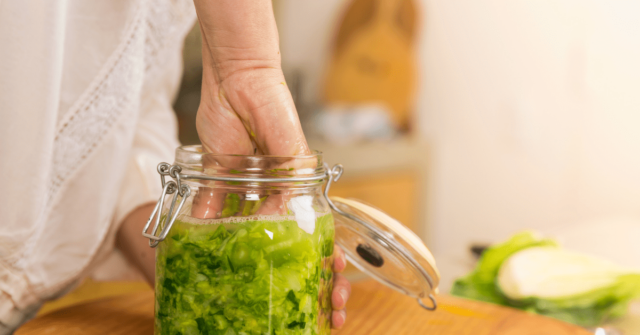Try these easy foods with probiotics for kids that may have amazing health and behavior benefits! Plus, learn how to make your own probiotic rich foods for your child or toddler.
Like most people, for years I’ve known that probiotics are good for us and surely good for our kids too, but over the course of the last year, I’ve become way more educated on just how critical they really are.
I’ve been learning how to support my health with food and literally cure some of my ailments that had been plaguing me for years… acid reflux, extreme fatigue, and headaches.
As I’ve studied and personally made huge lifestyle changes to my diet, I’ve learned how our gut – that’s everything from our throat through our intestines – has an affect on all areas of our health. There’s actually a proven mind-gut connection! While I’ve been on a journey to heal myself first, it’s impossible not to acknowledge the glaring truth that what our kids are eating is affecting their gut and consequently their health and behavior.
I’ve had to wrestle with that realization against what I know as a feeding therapist and how we handle foods with kids. I strongly believe that we shouldn’t demonize certain types of food for kids, or lecture endlessly about health and nutrition because it often creates a deeper desire for those unhealthy foods.
One way we can help give our kids a healthy gut and added nutrition though is to start offering foods with probiotics that kids and toddlers will be more likely to eat!
Does Your Child Need Foods with Probiotics?
You may be wondering if your child really needs probiotics, and most doctors would say yes, they can be a great supplement, but aren’t necessarily mandatory. In this post, we’re not talking about probiotics in pill form, although that’s an option, instead, we’re going to focus on ways to include them naturally in the foods your child eats.
The bottom line is, in general, they’re beneficial for most kids. And, can be particularly helpful for a variety of challenges kids face…
Probiotic Foods Can Be Very Helpful for Kids with…
It may surprise you to learn just how many “issues” kids face that can be helped by probiotics. This gets back to the mind-gut connection, as well the obvious sorts of digestion issues. Probiotics actually are small bugs, good bacteria, that go into our entire digestion track (aka gut) and destroy the bad bacteria that we acquire from foods we eat and various medications.
Gut health for kids is a big deal, one that we’re only starting to realize the implications for.
This is a list of the some of the most common challenges probiotic foods for kids may help with:
- Constipation (be careful of dairy though, many kids are sensitive to it and it can worsen constipation, even if it includes probiotics as with dairy)
- Diarrhea
- Acid Reflux
- Frequent upset stomach
- Extreme fatigue
- Anxiety and chronic worrying
- Poor attention
- Poor memory
- Poor behavior (frequent tantrums)
- Frequent illness/poor immune system (See this post on How to Boost Your Child’s Immune System for more ideas)
Of course, any of these issues listed above could have multiple layers and causes attached to them. In some cases, probiotic foods may show a drastic improvement and in others, additional interventions and strategies will be needed.

Some Guidelines for Foods with Probiotics for Kids
Different foods have varying levels of probiotics, or good bacteria, naturally inside of them. In the world of gut health, there’s a separate category all unto it’s own, that are truly super probiotic foods. They are fermented foods.
Fermented foods have become more popular in recent years. Think kombucha, kefir, and even homemade sauerkraut.
These fermented foods are awesome, and I will share some specific ones that work great for kids, but they do pack a big punch. Meaning there’s a lot of probiotics inside of them. If you or your child start to eat these fermented foods (and I hope you do!), take it slow. That means about 1 tbsp or so the first time and slowly increasing from there.
A huge onslaught of even good bacteria when your child’s body isn’t used to it, could leave them feeling bloated.
Other foods that have some probiotics in them are at a lower volume, such as yogurt, and can be consumed in normal portions. If you’re giving your child a new probiotic food, always watch for any reaction after eating, even up to 48 hours later.
Lastly, if you have any reservations at all or questions, check with your child’s doctor.
What Age Can You Give Your Kid or Toddler Foods With Probiotics
There is a lack of research in the area of when it’s a good time to start probiotic foods with kids, toddlers, or even babies, but most doctors and health care practitioners are comfortable at 9 months of age and up.
Again, remember to exercise the above precautions in particular with babies!
Foods With Probiotics for Kids and Toddlers!
You’ll find there’s a few categories of probiotic foods for kids below. One is for foods that have probiotics/good bacteria naturally occurring, but the level of bacteria in them varies quite a bit. Another list is for those super probiotic foods: ferments. Fermented foods can be purchased in the store, and I’m seeing them become available more often.
One helpful tip is to make sure that whatever food you’re buying contains live cultures or strains. It usually says this right on the front of the package, but if you’re not sure, look at the list of ingredients you should see words like Lactobacillus acidophilus and Bifidobacterium bifidum.
Then, rotate through brands as much as possible, because when fermented foods are manufactured, they include specific strains of bacteria to ensure the taste is always the same.
Rotating through brands gives a larger variety of that good bacteria, and that’s what you want. But, I also want to encourage you to consider making your own fermented foods as this contains tons more strains of bacteria and it’s SUPER cheap.
Foods With Built-In Probiotics
All you have to do is pick up these foods at the grocery store:
- Yogurt – make sure it contains “live cultures”
-
- Yogurt can also be made at home and is a fully fermented food. Here’s a recipe if you want to make your own!
-
- Sourdough bread
- Gouda, Swiss, Cheddar, and Parmesan cheese
- Peas – try them frozen or fresh
- Cottage Cheese – make sure it contains “live cultures”
Foods With PreBiotics
Prebiotics are good food for probiotics so you may want to include these in your child’s diet too:
- Bananas
- Barley
- Apples
- Flaxseed (think about grinding and mixing into oatmeal or yogurt)
- Onions
- Asparagus
Foods You Can Easily Make to Create Probiotics (aka Fermented Foods) That Kids Will Actually Eat
My family has been fermenting our foods for about 3 months now, and I’ll be the first to admit that at first, I was overwhelmed with getting started even though I knew how important it was. I thought that there was some sort of magic or difficult chemistry that would take place, completely not the case. Making your own fermented and probiotic-rich foods couldn’t be simpler
Fermenting your own foods is something people have been doing in their kitchens for thousands of years, I promise you can handle it too and the benefits are amazing!
These are some of my favorite fermented foods for kids, the links are to simple recipes:
- Fermented Dill Pickle Green Beans – Hands down my kid’s favorite. Every one of my kids devours these. They are tremendously easy to make, as all you need to do is take fresh green beans, put them in mason jar, cover with water, sea salt, dill, and some garlic (we omit the pepper). You let it sit on your counter for a few days and, voila, crunchy crisp green beans that you’d swear were a pickle!
- Fermented Pickles – These are super good too, just don’t cut your cucumbers to thin or they won’t be crunchy! The instructions are pretty much the same as above.
- Fermented Ketchup – This has a little bit of a tangier/sour taste then regular ole’ ketchup, but making a small batch can help get tons of good probiotics in any ketchup lover.
- Fermented Mild Salsa – Serve this will tortilla chips and some avocado!
- Fermented Ranch – Perfect for the ranch dipping type!
- Sauerkraut – Yes, I’m listing this here for kids! Homemade fermented sauerkraut is quite different than the kind you buy in a bag. It does still have a particular smell, although not nearly as strong. Admittedly, only one of my kids has jumped on the sauerkraut band wagon, but friends of ours (who have taught me a lot about fermenting) have two kids that ask for it!
A Couple of Notes on Fermented Probiotic Foods
The foods that you ferment will be kept in a mason jar, or possibly a crock if you’re going big! You can make several jars at once or just start one. You’ll need to store them on a counter or a dry place. Most foods take 4 days or so to fully ferment at room temperature.
You’ll know your food is ready because you’ll see bubbles or some juice may leak from it – those are good things.
If your probiotic rich fermented food doesn’t seem to be doing anything, smell it. If it smells foul, it didn’t take and you’ll have to toss it. But, this has rarely been our experience!
It’s also a possibility that some mold can form on the top, this is normal. You’ll want to just scrape it all off. Filling your food and liquid close to the lid will help prevent this!
Affiliate links used below. See our full disclosure.
Basic Supplies for Getting Started with Fermented Foods
If you’re ready to use any of the above recipes, there’s a couple of basic tools/ingredients you need to get started. You may have everything you need already in your kitchen:
- Sea Salt – This un-iodized version of salt is important, you can pick it up at any grocery store or here. Iodine can inhibit the fermentation process.
- Filtered Water – We’ve used our refrigerator filtered water just fine, but completely de-clorinated water can be found in jugs at your local store.
- Mason Jars – It doesn’t need to be sterile, just clean. You’ll need to remove the lid once a day to let the gasses out. If you need some, you can grab them here.
- Burping Lid – This is not a necessity, but does make like easier because this lid means you can walk away without ever having to release the gasses.
- Fermentation Stones – These glass stones keep food from floating to the top. They are typically needed for foods like sauerkraut or dips, but are very helpful for green beans and pickles!
There’s No Way My Kid’s Eating Fermented Foods…
I hear you! And, the truth is, they may not eat it right away, especially if fermented/probiotic foods are totally new for your family. They will likely need to see you eating it many times, cook some together, and not have any pressure to try it before they do. See this post on tips for cooking with kids.
As with all new foods with kids, especially picky eaters, it may take lots of attempts and consistency. It may take touching, cutting, smelling, and licking the probiotic foods before they’re willing to eat them. While I think probiotic foods are incredible and worth the effort, they can also be a long term goal. Start simply and see where it goes. At a minimum, these foods are really good for you too!
If probiotic foods and fermented foods are a totally new concept to you, take your time in starting to think about how you can incorporate these into your families meals.
For toddlers, you may be able to mix some into mashed potatoes or yogurt. Or, for older kids, maybe it’s part of a snack when they come in starving after a long school day! For my family, this is a work in progress. I don’t want to force anything or create negative experiences, but I do want to introduce my kids to foods I know are amazing for their growing bodies.
Now it’s your turn, I want to hear from you… Are you willing to try fermented and probiotic foods? Are you already using some? Tell me in the comments below!
References for Foods with Probiotics for Kids
1. Johns Hopkins Medicine. The Brain-Gut Connection. [Web log post]. Retrieved from https://www.hopkinsmedicine.org/health/healthy_aging/healthy_body/the-brain-gut-connection
2. Shewell, L. (2015, October 30). Everything u=you always wanted to know about fermented foods. Retrieved from sciencebasedmedicine.org/everything-you-always-wanted-to-know-about-fermented-foods/
3. Donovan SM & Shamir R (2014). Introduction to the yogurt in nutrition initiative and the First Global Summit on the health effects of yogurt. The American Journal of Clinical Nutrition 99(5 Suppl):1209S-1211S
4. Parvez S, Malik KA, Ah Kang S, & Kim HY (2006). Probiotics and their fermented food products are beneficial for health. Journal of Applied Microbiology 100(6):1171-1185
5. Vitetta L, Briskey D, Alford H, Hall S, & Coulson S (2014). Probiotics, prebiotics and the gastrointestinal tract in health and disease. Inflammopharmacology 22(3):135-154
Alisha Grogan is a licensed occupational therapist and founder of Your Kid’s Table. She has over 14 years experience with expertise in sensory processing and feeding development in babies, toddlers, and children. Alisha also has 3 boys of her own at home. Learn more about her here.
More on Healthy Eating for Kids
The Super Easy Healthy School Snack List with Printable
Immune Booster Carrot Cake Smoothie for Kids
High Fiber Immune Boosting Banana Sweet Potato Pumpkin Bread
Unbelievably Easy Healthy Meals for Picky Eaters (+Free Printable)

